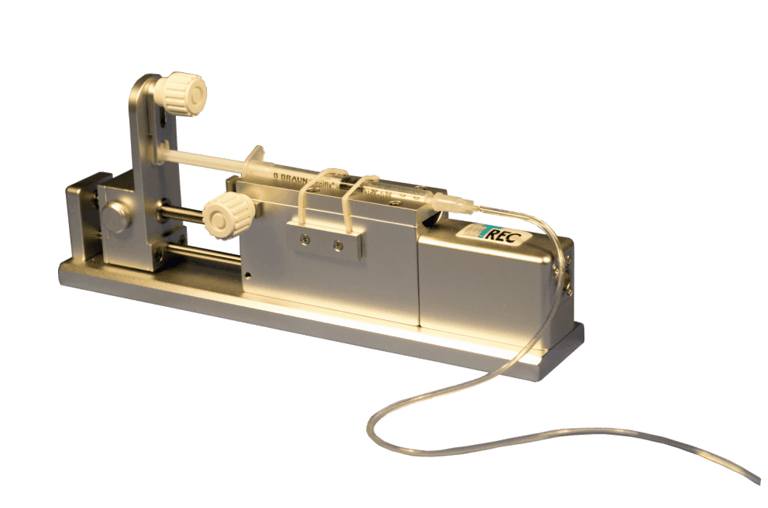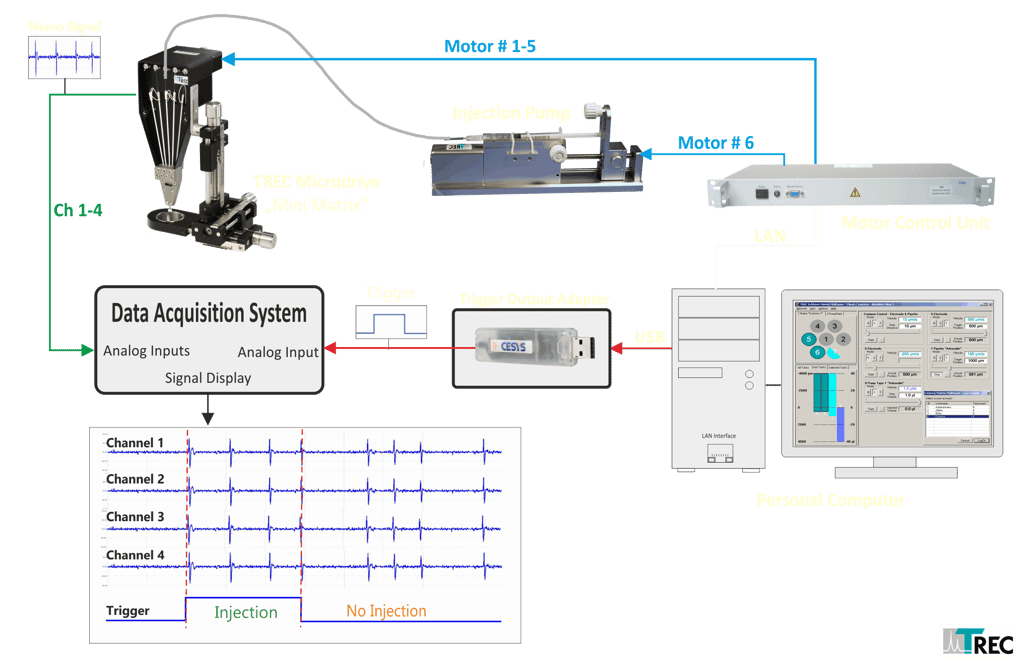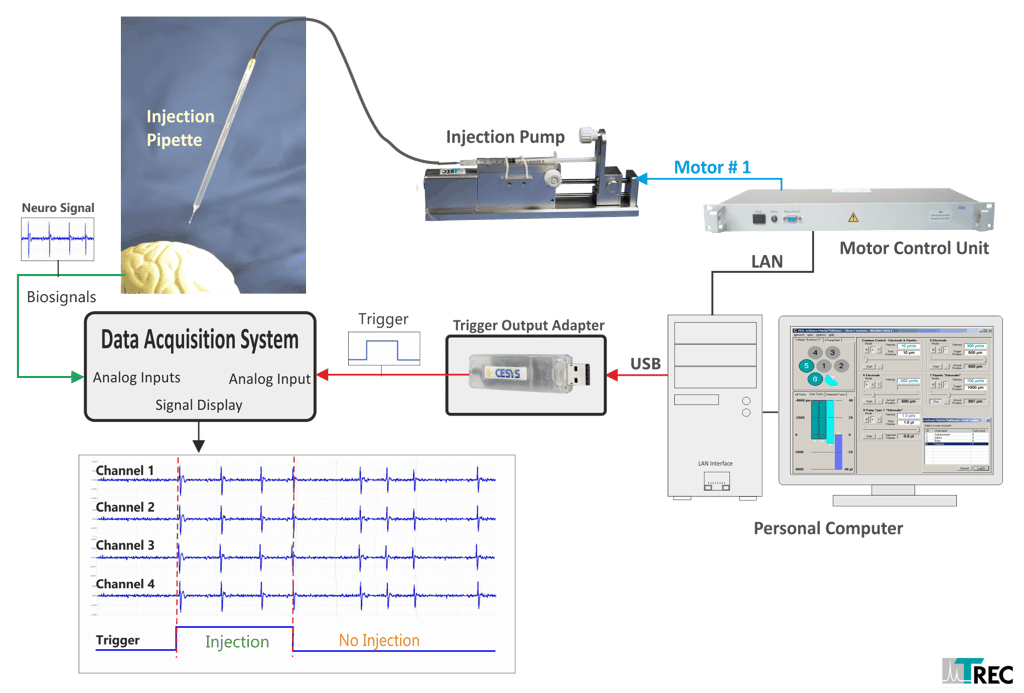Microinjection System (MIS)
(Motorized Pump System)


Product Description
The Thomas RECORDING Microinejction System (MIS) uses a software controlled motorized microinjection syringe pump (MIP). This MIS is available in a version to be used with Thomas multielectrode microdrive systems such as the “Eckhorn Matrix” or the “Mini Matrix”. Furthermore we offer the MIS as a stand-alone version for other applications. The motorized syringe pump (MIP) is shown in the picture on the right side.
Microinejction System (MIS)
for Thomas fiber electrode manipulators
Thomas RECORDING microinjection system (MIS-03) for TREC fiber electrode manipulators (e.g. Mini Matrix, Eckhorn Matrix or Thomas Matrix). This picture shows the block diagram of the MIS-03 used with a Thomas 5 electrode Mini Matrix system in an injection/recording configuration. This system allows to place one injection cannula and 4 microelectrodes with high spatial resolution in the brain, to inject a drug in the direct vicinity of the recording electrodes and to record the neural response with up to 4 microelectrodes simultaneously. The trigger output of the injection system is optional available and allows to record the time stamps for start and stop of the drug injection simultaneously with neural response.




Stand-alone microinjection system MIS-03. The stand-alone version contains a microinjection pump, a motor control unit and a software. The trigger output is optional available. For recording the neural response any other neurophysiological recording system can be used.
Microinjection System (MIS)
stand slone system
This version of the MIS allows to connect the MIS microinjection pump to the motor control unit of the Microdrive system (MCU-2) and to use one software to control electrode and pipette positioning and the drug injection rate.
The configuration shown in the block diagram above allows drug injection in the direct vicinity of the recording site. The Thomas Mini Matrix microdrive can place several recording microelectrodes (OD=80µm) and a microinjection cannula (OD=115-120µm) with high precision in the animal´s brain. The software of the microdrive controls the positioning of the recording electrodes and the injection cannula as well as the drug injection rate of the microinjection pump. The pressure injection of neuropharmacological substances during single-cell recording with the Thomas MIS and a Tetrode Mini Matrix system in an awake, behaving macaque monkey was published by Veith et al. in 2016 [1, see below]. The authors demonstrate the combination of acute single-cell recordings with the injection of neuropharmacological agents in the direct vicinity of the recording electrodes. A video shows the preparation of the pressure injection/recording system, including preparation of the substance to be injected. The authors show a rhesus monkey performing a visual attention task and the procedure of single-unit recording with block-wise pharmacological manipulations.
Comparison to alternative methods
Veith et al. [1] have compared the MIS and the Mini Matrix system with other microinjection systems. The authors stated that the system used in their application showed clear advantages compared to other pressure injection systems. They found that one strong advantage is the diameter of the micropipette (approximately 100 µm), which is half the size of other available probes and therefore minimizes neural tissue damage. In contrast to previous designs, the current system employs spatially separated recording electrodes and micropipette. The system described in the publication allowed independent depth changes of electrodes and pipette, thus permitting variable relative distances within a recording session. The authors stated that no compromise regarding recording quality needs to be made, as the MIS is an extension of the established Thomas recording device. While only one micropipette and thus one substance was used in the described application, it is possible to inject several substances within one experimental procedure. To achieve this, several micropipettes can be loaded into separate Mini Matrix guide tubes and connected to syringes mounted in individual injection pumps of the MIS. Finally, the authors reported that controlling the system was easy, as only one computer program was needed to advance the electrodes and micropipette, and to perform the pressure injection during the experiment.
[1] Vera K Veith, Cliodhna Quigley, Stefan Treue
J Vis Exp. 2016 Mar 14:(109):53724. doi: 10.3791/53724.
Selected Publications
[1] Vera K Veith, Cliodhna Quigley, Stefan Treue
J Vis Exp. 2016 Mar 14:(109):53724. doi: 10.3791/53724.
[2] Vera K Veith, Cliodhna Quigley, Stefan Treue
Cholinergic manipulations affect sensory responses but not attentional enhancement in macaque MT
BMC Biol. 2021 Mar 16;19(1):49. doi: 10.1186/s12915-021-00993-7.
Request Information
Location
Winchester Strasse 8
35394 Giessen, GERMANY
Hours
Mo.-Fr. 8:00 a.m - 4:00 p.m.
Central European Time (CET)
Sa. - Su. Closed
info@ThomasRECORDING.com


